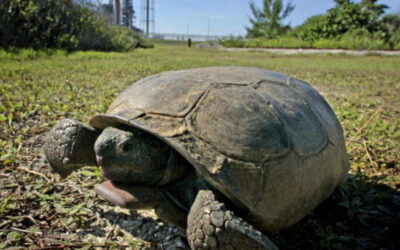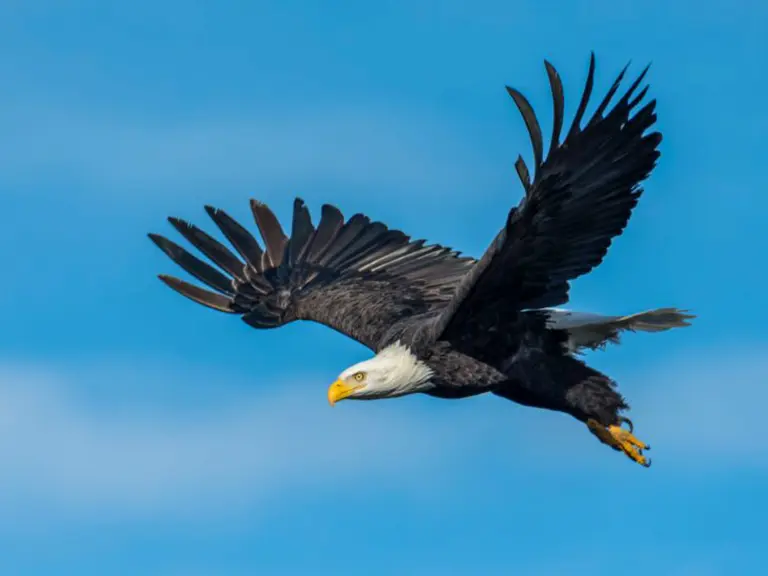Gopher Tortoise
Cape Coral’s Terrific Tunnelers
Imagine that you must protect yourself from the elements, and to do so, you have to dig a tunnel in the ground that is as wide as your body, 15 – 30 feet long, and 6 feet deep at the end. Not only is this activity vital to your protection, but many others depend on your tunneling ability for their own shelter, food and growth. You can’t use any machinery, not even a shovel. You do it with your bare hands. Most of us would say, “forget it”. But for the gopher tortoise, the tunneling is all in a day’s work.
Description
The gopher tortoise (Gopherus polyphemus) averages 11 inches long, but can attain lengths of 15 inches. They can weigh up to 15 pounds, but typically weigh about 8 to 10 pounds. Gopher tortoises are found throughout Florida and prefer sandy, well drained upland areas, they eat grasses, bean family plants, fruits and grass – like plants.


Habitat
The gopher tortoise’s large, flattened forelimbs have special ligaments that stiffen making it easier for these incredible animals to dig large tunnels, some more than 30 feet long. These tunnels, called burrows, provide shelter from extreme heat or cold, maintaining a temperature of 70 – 80 degrees in the summer, and 60 -70 degrees in the winter. The tortoise’s burrow and the excavated sand around the entrance are used by many other invertebrate and vertebrate species to varying degrees. The loss of gopher tortoises habitat means the loss of habitat for up to 300 “commensal” (harmonious co – existence) species.
In Cape Coral, there can be scattered enclaves of one to five tortoise burrows on vacant lots, as well as a few areas containing ten to forty burrows. The gopher tortoise’s burrow can be recognized by it’s half moon shape and the mound of sand often 3-6 feet wide at the entrance. The burrows of young gopher tortoises or hatchlings are not so large. A year after hatching, gopher tortoises usually have a burrow 3-4 feet deep.
Reproduction
Gopher tortoises may live more than 40 years, but do not reach reproductive maturity until 10 – 20 years of age. Mating occurs April to June, with females digging their nest cavity in the mouth of the burrow only once per year. The means the nest size is about six eggs. The incubation period varies from approximately 80 to 110 days.
History
The gopher tortoise was well established in Florida thousands of years before human existence. Human consumption and encroachment, resulting in loss and degradation of habitat has contributed substantially to their population decline – about 80 percent over the last one hundred years. In addition, the gopher tortoise does not reach reproductive maturity until ten twenty years of age, their eggs often succumb to predation, and many are plagued by a life- threatening respiratory disease. All these factors have contributed to the need for the gopher tortoises to be on the Florida Fish & Wildlife Conservation Commission’s Protected Species List. Out of every 100 eggs laid, it is estimated that only 1-3 survive to the adult breeding stage
The Future
Though much of the upland habitats needed for tortoises have been developed on Sanibel, a few upland areas containing high densities of tortoises remain as conservation lands. These populations cannot be counted on however to ensure long term survival of gopher tortoises on Sanibel. Other small populations located in community conservation easements and backyards will be needed to best ensure long-term viability. The gopher tortoise is a fascinating and gentle creature whose importance in our local ecosystem cannot be overstated. Never chase or harass a gopher tortoise. This stresses the animal and can interfere with it foraging activities.
Gopher tortoises are land animals. Please don’t put them into a body of water where they can drown.
If helping one safely across the road, stop your car and wait for it to cross or place it on the side it was heading toward.
For injured tortoises, call 239-472-3644 (Clinic for Rehabilitation of Wildlife, CROW)
If you see a malicious destruction or harassment of Gopher Tortoises call Florida Fish and Wildlife Conservation Commission at 1-888-404-3922
Research by Dr. John Herman of Florida Gulf Coast University demonstrated that “the urban gopher tortoise populations in Cape Coral represent a self-sustaining viable conservation unit.” For this reason, Professor Herman “fully supports and encourages the establishment of a land trust of current vacant lots…for the conservation of gopher tortoises specifically and wildlife in general.”
In fact, more than 350 other species – burrowing owls, coyotes, snakes, foxes, mice and more use tortoise burrows to seek shelter and escape heat, fires, and predators. The gopher tortoise is considered a “keystone species.” Conservation Biologist Rachel King of Florida Fish & Wildlife further explained “If they disappear from the environment, the ecosystem will collapse on itself.”
You can help preserve this keystone species and the ecosystem they support by donating to our Cape Coral Wildlife Trust.
Gopher Tortoises in the News
“CHARGING” – Nature of Cape Coral Bus Tour – Cape Coral Wildlife Trust’s Gopher Tortoise Preserve
Imagine having the rare opportunity to have this “CLOSE ENCOUNTER” happen to you! Thank you to Charles Wellhausen for sharing this amazing video!
Cape canals, wildlife disturbed in Ian debris cleanup
It has come to Cape Coral Friends of Wildlife’s attention that overzealous debris removal crews with huge excavators and tandem debris trucks are scraping the lots and the banks of canals across a wide swath of Cape Coral.
Burrowing owls defenders say heavy equipment for Hurricane Ian debris is crushing underground nests
The passionate defenders of Cape Coral’s burrowing owls are livid now that tractors are clearing debris from Hurricane Ian out of the city’s canals and possibly crushing dozens of owl and gopher tortoise burrows.
How Florida wildlife is faring after Hurricane Ian
Ian resulted in the deaths of at least 130 people and displaced thousands more. Now, as residents begin to rebuild, questions remain about the future of its diverse, critically important native species.
US wildlife officials deny increased gopher tortoise protections
The destruction of a once-thriving gopher tortoise community in Lehigh Acres last week typifies what’s happening to the threatened species throughout Southwest Florida, advocates say.
Truck drives over lot littered with gopher tortoise burrows
Neighbors in one Cape Coral neighborhood say they’re keeping an eye out for a pick up truck caught on camera driving through an empty lot that’s bustling with gopher tortoise burrows.























